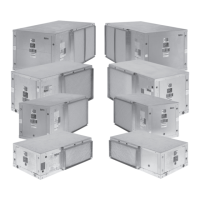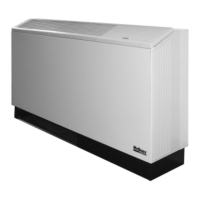IM 778 / Page 25
Troubleshooting
The in and outs of R410A
Refrigerant 410A is a non-ozone depleting blend of two
refrigerants HFC-125 and HFC-32 in a fifty percent mixture.
Refrigerant 410A exhibits higher operating pressure and
refrigeration capacity than R-22. R-410A refrigerant is
intended for use in new air conditioning application that has
traditionally been serviced by HCFC-22 or R-22. Due to
higher capacity and pressure of R-410A, it is not recom-
mended as a retrofit to existing R-22 systems.
Although R-410A is non-flammable at ambient temper-
ature and atmospheric pressure, it can become com-
bustible under pressure when mixed with air. (NOTE: R-
410A should not be mixed with air under pressure for
leak testing. Pressure mixtures of dry nitrogen and R-410A
can be used for leak testing.)
Lubrication
R410A should be used only with polyolester (POE) oil. The
HFC refrigerant components in R-410A will not be compat-
ible with mineral oil or alkylbenzene lubricants. R-410A sys-
tems will be charged with the OEM recommended lubri-
cant, ready for use with R-410A.
Charging
Due to the zeotropic nature of R-410A, it should be charged
as a liquid. In situations where vapor is normally charged
into a system, a valve should be installed in the charging
line to flash the liquid to vapor while charging.
General Maintenance
1. Normal maintenance on all conditioners is generally lim-
ited to filter changes. Motors used with WSHP unit size
007 through 060 are provided with permanently lubricat-
ed motors and require no oiling even though oil caps may
be provided.
2. Filter changes are required at regular intervals. The time
period between changes will depend upon the project
requirements. Some applications such as motels pro-
duce a lot of lint from carpeting and linen changes, and
will require more frequent filter changes. Check filters at
60-day intervals for the first year until experience is
acquired. If light cannot be seen through the filter when
held up to sunlight or a bright light, it should be changed.
A more critical standard may be desirable.
3. The condensate drain pan should be checked annually
and cleaned and flushed as required.
4. Record performance measurements of volts, amps, and
water temperature differences (both heating and cooling).
A comparison of logged data with start-up and other
annual data is useful as an indicator of general equipment
condition.
5. Periodic lockouts almost always are caused by air or
water problems. The lockout (shutdown) of the condition-
er is a normal protective result. Check for dirt in the water
system, water flow rates, water temperatures, airflow
rates (may be a dirty filter), and air temperatures. If the
lockout occurs in the morning following a return from
night setback, entering air below machine limits may be
the cause.
Make certain that the recycle or recovery equipment used
is designed for R-410A. The pressure of R-410A refrigerant
is approximately 60 percent greater than that of R-22.
Pressure gauges require a range up to 800 PSIG high side
and 250 PSIG low side. Recovery cylinders require a 400
PSIG rating – do not put R-410A in a 300 PSIG rated
cylinder.
(NOTE: because a water source heat pump operates under
a wide range of water and air temperatures, the values
printed below are to be taken as suggested pressure and
temperatures.) All McQuay water source heat pumps are
designed for commercial use. The units are designed for
the cooling mode of operation and fail safe to cooling. The
reversing valve is energized for the heating mode of
operation.
Superheat Head Pressure Water Delta T
8 to 14 degrees 335-355 PSIG 10° to 12°
All information above is based on ISO standard 13256-1
and are tested at these conditions.
Recycle/recovery equipment must be designated for
R-410A. R-410A pressure is greater than R-22.
Improper equipment can cause severe injury or death.
